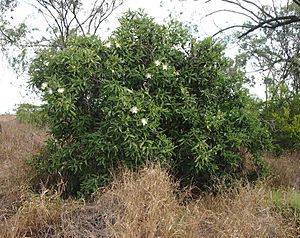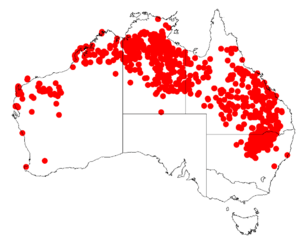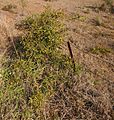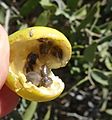Capparis lasiantha facts for kids
Quick facts for kids Capparis lasiantha |
|
|---|---|
 |
|
| Scientific classification | |
| Genus: |
Capparis
|
| Species: |
lasiantha
|
 |
|
| Occurrence data from GBIF | |
Capparis lasiantha is a special plant that grows only in Australia. You might know it by its many common names like Wyjeelah, Nepine, Split Jack, Native Orange, or Bush Caper. This plant can be found across a large part of Australia. It grows from The Kimberley in Western Australia, through the Northern Territory, and into Queensland and northern New South Wales. It mostly prefers dry areas inland, but you can also find it near the coast in Central Queensland.
Contents
About Its Name
A Swiss plant expert named Augustin Pyramus de Candolle first described Capparis lasiantha in 1824. He wrote about it in his book Prodromus Systematis Naturalis Regni Vegetabilis. The plant still has the same scientific name today! Another botanist, Robert Brown, had seen it first. But de Candolle added more details to make sure everyone could tell it apart from other plants. That's why both their names are part of its full scientific name: Capparis lasiantha R.Br. ex DC.
How It Grows
When Capparis lasiantha plants are young, they start as climbing vines. They use sharp spines on their stems to hold onto other plants. Some plants stay as climbers even when they are fully grown. Others grow into a scrambling bush that can reach up to 3 meters (about 10 feet) tall.
Flowers and Fruit
When the plant is mature, it grows large, white flowers that smell lovely. After the flowers, hard, round fruits appear. These fruits are about 2 to 4 centimeters wide. When the fruit is ripe, it becomes soft and smells sweet. It then splits open to show a tasty, edible pulp around the seeds.
Aboriginal people across Australia used this fruit as an important food source. They also used the bark to make a special mix. This mix helped treat bites and stings from animals, especially in the Broome area. Farmers found that the leaves could be used to feed their livestock during dry times when other food was scarce.
Plant Friends and Visitors
Some animals and plants like Capparis lasiantha too! The caterpillars of the caper white butterfly (Belenois java) love to eat its leaves. Also, another plant called Lysiana subfalcata, which is a type of mistletoe, has been found growing on Capparis lasiantha.
Growing Your Own Bush Caper
Capparis lasiantha is a tough plant that can handle dry weather. This makes it a great choice for gardens in dry or warm areas. Its beautiful flowers and edible fruit make it a good plant to grow. You can start new plants from its seeds.
Gallery











